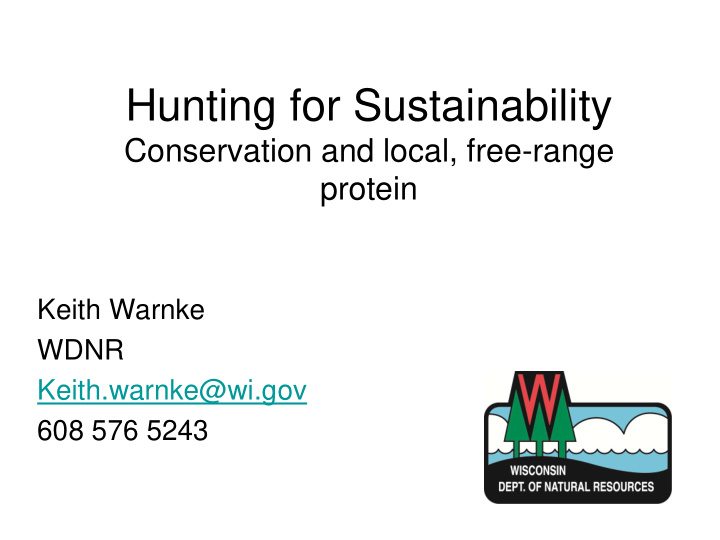



Hunting for Sustainability Conservation and local, free-range protein Keith Warnke WDNR Keith.warnke@wi.gov 608 576 5243
Why Hunt? • Sustainable, free-range protein is available through hunting • Conservation • Connection • Think about the food!
Where are we headed? - Predictions Trends – Hunter Projection: 2008-2030 Expecting a 27% decline 650,000 600,000 550,000 500,000 450,000 400,000 350,000 300,000 2000 2002 2004 2006 2008 2010 2012 2014 2016 2018 2020 2022 2024 2026 2028 2030
What to do? • Standard model: – Reach out with youth programs
Hunting motivations
Where is the interest? CSA programs Farmers markets Slow Food movement
Resources • Where are we going to get NEW hunters? • From NEW sources outside the box • ADAPT!
What did we do? • Food as an universal motivation to hunt
Hunting For Sustainability Trying to reach a new audience and rebrand hunting
How do we reach out to people who appreciate this…
…but need a mentor to show them?
In a classroom? With a group of adults?
5 week course with 3 field trips • Week 1 - History, demographics, ethics, and “green eating.” Note: Always serve food at class!
Week 2 - Wildlife Management, public lands, scouting, and Hunting regulations.
Week 3 - Hunting for health and wellness, Hunting skills and equipment
Week 4 - Agricultural damage program and discussion
Week 5 – Wrap up, focus on hunting field trip
Gun handling Each week we ended with 30 minutes of safe gun handling where everyone became familiar with and used all the action types in a controlled setting
Field Trips
The Hunt • Ten hunters • Twelve mentors* • Deer camp style
Goals • Provide tools, knowledge, and experience • Follow up offer assistance where possible • Set systems in place to see if they become long term hunters
Results • Too early • Several bought guns and taken hunter ed • Nine of ten participants bought deer hunting licenses • Several are returning for more
Next Steps • Repeated contacts – More experiences – rabbit, turkey, pheasant, etc. • More courses • Define effective • Track and evaluate • Adapt
The finished recruit “I believe one • Young adult could say that I am hooked.” • LTH turkey and deer • Hunting for Sustainability • HE test out • Purchased firearm • $5 first time license • Hunted on MFL land • Killed his first deer • Home butchering
Break Slide Questions?
What’s in a Brand? • the name, term, design, or symbol that identifies one’s product
We certainly have a “brand”
Evolution of hunting “brand” “Market hunting”
Evolution of hunting “brand” “Sport Hunting” • Fair chase • Self restraint • Vigorous life • American ethnic identity (Herman, 2001)
Evolution of hunting “brand” “Wildlife (game) crops” 1933-1970 • Harvestable surplus • Habitat conservation • Predator control • Stocking
Current of Branches of “Sport“ Hunting Brand a tool a recreation as achievement • Big game emphasis • Multiple • Controlling satisfactions populations • Trophies (QDM) • Leisure pursuit • Disease • Specialization management • More than • Where the money harvest • Funding is… Source
Problems with all three branches Hunting as recreation • Too many other outlets • Trivializes its role and potential importance •
Problems with… management tool branch • Not customer focused • Runs counter to hunter perceptions • What about carnivores? • Risky financial strategy
Problems with… Hunting as achievement • Lacks public support • Outcome focused • Creates competition, jealousy/ greed drives privatization, reduced access • May intimidate newcomers
Stewardship Brand ? Hunting as a means of engaging citizens in participatory, authentic, and sustainable lifestyle that results in a strong connection to conservation. • Limiting your footprint • Biodiversity focus, not game species focus • Caretaker function — mentoring others, allowing access (landowners), citizen science, volunteers projects
Challenges to overcome • Land Access • Re-visioning hunting recruitment & socialization • Urban epistemology (Muth & Jamieson, 2000) • Institutional buy in
How to reach the Stewardship brand? • Involve and engage sustainable community • Own current brand and work to improve it
What can you do? Contact me: Keith.Warnke@wi.gov 608 576 5243 Thank you!
Recommend
More recommend